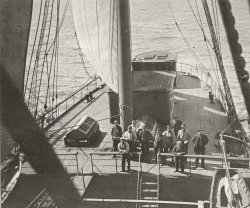
MAY CONTAIN NUTS

Search Shorpy
SHORPY ART

Framed or unframed, desk size to sofa size, printed by us in Arizona and Alabama since 2007. Explore now.
Join and Share
Ad-Free Shorpy
Shorpy is funded by you. Patreon contributors get an ad-free experience.
Learn more.

Recent comments
- Texas Flyer wanted
- Just a Year Too Soon
- WWII -- Replacing men with women at the railroad crossing.
- Yes, Icing
- You kids drive me nuts!
- NOT An Easy Job
- I wonder
- Just add window boxes
- Icing Platform?
- Indiana Harbor Belt abides
- Freezing haze
- Corrections (for those who care)
- C&NW at Nelson
- Fallen Flags
- A dangerous job made worse
- Water Stop
- Passenger trains have right of way over freights?
- Coal
- Never ceases to amaze me.
- Still chuggin' (in model form)
- Great shot
- Westerly Breeze
- For the men, a trapeze
- Tickled
- Sense of loneliness ...
- 2 cents
- Charm City
- What an Outrage
- Brighton Park
- Catenary Supports
Member Photos
The Shorpy
Print Emporium
Print Emporium
Search Shorpy
Search results -- 30 results per page
- Biloxi Shrimps: 1911
- ... March 1911. Biloxi, Mississippi. "View of the Gorenflo Canning Co., taken at 7 a.m. Many tiny workers here, some of whom began to ... Posted by Dave - 09/17/2009 - 3:47am -
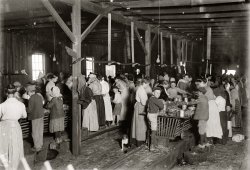
- Baby Vegetables: 1940
- July 1940. "Canning beans in farm kitchen near Bristol, Vermont." Photo by Louise Rosskam ... and join the action! It brings back lots of memories of canning various fruits and veggies, with my mother-in-law, sisters-in-law, and ... Posted by Dave - 08/01/2012 - 4:54am -
![Baby Vegetables: 1940 July 1940. "Canning beans in farm kitchen near Bristol, Vermont." Photo by Louise Rosskam for the Farm Security Administration. View full size.
All growed up - and then someOur cheerful baby would now be 73 years old. It would be nice to see a photo of her (him?) today. Google People View?
Old things!Oilcloth and enamel pots and pans. Two neat old things you just don't see anymore.
May I join you?This is one of those pictures I sure wish I could walk into and join the action! It brings back lots of memories of canning various fruits and veggies, with my mother-in-law, sisters-in-law, and various friends. It's a big job, but a lot of fun, if there is good company, during it. Not much is so gratifying as seeing rows of filled jars, from the Summer and Fall bounty, knowing that one's family will benefit from it when there is snow on the ground!
1940?The calendar on the wall reads "1937."
[Being used for decor. Below, a shot a few frames away on the same roll. - tterrace]
BabyThat's about the most gleefully happy baby I've seen in one of these pictures. Must be thinking about eating those beans.
Let's see that calendarCan you zoom in on that calendar? It almost looks like it says "C. A. Donah" on it.
[Alas, it's not clear on the the full-size original. - tterrace]
Well-ShodMom and Grandma wearing some nifty shoes.
(The Gallery, Kids, Kitchens etc., Louise Rosskam)](https://www.shorpy.com/files/images/SHORPY_8b30802a.thumbnail.jpg)
- The Apprentice: 1911
- ... of Mrs. Cora Croslen, of Baltimore. Both work at Barataria Canning Co. (shucking oysters). The mother said, 'I'm learnin' her the trade.'" ... Posted by Dave - 08/26/2009 - 6:23pm -
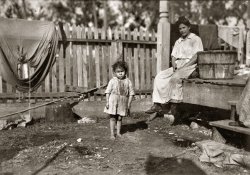
- Porch of Plenty: 1957
- ... took staged photos to the same insane levels they took canning and preserving. It didn't suffice that every surface in the kitchen was ... Posted by Dave - 12/02/2019 - 1:52am -
![Porch of Plenty: 1957 September 1957. "The Willis Cooper family on the front porch of their farmhouse near Radcliffe, Iowa, surrounded by animals and foods." 35mm color transparency from photos by Jim Hansen for the Look magazine assignment "Iowa family." View full size.
What the heckLooks like moving day.
American GothicRedux.
Interesting ladyhttp://www.funeralmation.com/index.cfm/obituary/4148225?browse_on=deskto...
Looks just like WilburCute little shoat he's holding there, and should be ready for slaughter this time next year.
Can we notI hate to be the one to say it but this family took staged photos to the same insane levels they took canning and preserving. It didn't suffice that every surface in the kitchen was covered with production results, and new surfaces had to be created, only to be covered like the others. Now the jars are hanging on the front of the house. Enough is enough already, folks. Start eating it.
[This is the vision of some magazine art director (or “producer,” as they were called at Look). The compliant Coopers, along with their Mason jars, are mere props. - Dave]
The producer needed to sit down and have a cookie.
There's no accounting for tasteMy hat is off to the Look producer who set all this up. He gave us two fantastic photos.
American AgrarianBeautiful home, beautiful crops, beautiful livestock, beautiful family. Jefferson would have loved this. Makes me wonder what is down the cellar steps.
Over-produced (and I don't mean the food)I can remember, growing up, how often LOOK photos struck me as so obvious, set up and posed, that they shouted fake. Sophisticated older me realizes that ALL photos are set up, but the LOOK ones still shout at me.
The cat!If this were my family, I'd be the little guy holding the cat. I don't see any dogs, that's good.
[Why does that cat quack? - Dave]
An interesting couple and a good lifeEveryone should read the obituary of Mrs. Cooper that was linked by robstercraws. Most people would think that the Coopers simply farmed and stayed in one place, eventually moving into town or into a retirement home. But the Coopers farmed in four different communities in Iowa. Mrs. Cooper was a registered nurse, which I'm sure was helpful with kids in the home, and a farmer husband; she also worked as a hospital nurse for 20 years in Iowa, continuing after a move to Arkansas in 1984. After that she got her real estate license and worked for a broker. Then in retirement, the Coopers ran a quilting business. They also managed to get their private pilot's licenses during the 1970s, and flew a Cessna 172 for ten years.
There's not as much information about Willis Cooper, but we do know from Mrs. Cooper's obit that the Coopers' first home after marriage was at Childress Army Airfield in Childress, Texas, where bombardiers and navigators were trained during World War II.
All in all, a good long life.
Children of the CornI’ve been waiting for someone to say it. I mean, those unblinking twins. They’re sitting right under the corn, for goodness sake.
(Kodachromes, Agriculture, LOOK)](https://www.shorpy.com/files/images/SHORPY-19726u.thumbnail.jpg)
- Cannery Rows: 1941
- ... of food by hand.
Lots of work I do a fair amount of canning, and that is an impressive bit of work there. They must have a very large family or they are canning for neighbors as well.
At that time, if you didn't have a pressure ... Posted by Dave - 02/19/2019 - 1:40pm -
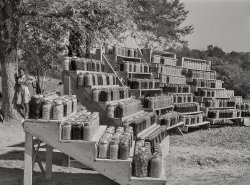
- Oyster Express: 1913
- ... February 1913. Bluffton, South Carolina. "Varn & Platt Canning Co. 10-year-old Jimmie. Been shucking 3 years. 6 pots a day, and a ... Posted by Dave - 03/16/2020 - 8:37pm -
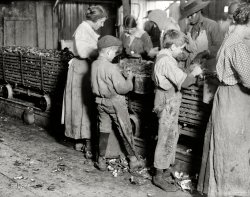
- Internal Revenue: 1926
- ...
These jobs make the prospect of stringing beans in a canning factory with 40 barefoot children look liberating.
This would seem ... Posted by Dave - 07/23/2012 - 3:38pm -
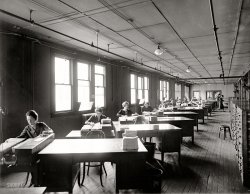
- All the Conveniences: 1920
- ... from the early 1930s that still gives processing times for canning meats and vegetables in just a water-bath canner. The very long ... Posted by Dave - 08/07/2012 - 1:38am -
![All the Conveniences: 1920 Another view of the circa 1920 kitchen from the previous post. The complicated-looking range-and-boiler combination seems to have been popular at the time. National Photo Company Collection glass negative. View full size.
On Hot WaterI had that very same water heater arrangement in the kitchen of a duplex I rented in Cambridge in 1965. My stove was different, and it had a space heater with coils for heating water. The "boiler" had a door that you opened to light the gas burner, which looked like an inverted shower head. If you weren't using the space heater when you needed hot water, you had to fire up the water heater, and then turn it off when the water was hot. Failure to do so would result in boiling the water in the pipes and seeing steam escape from the pipe joints. Don't ask me how I know that!
Outlets Aplenty! I am quite jealous, this kitchen has TWO electric outlets, with possibly another provided on the wall supported light fixture. My 1925 kitchen (barely updated) has only one.
No Vents!I noticed in both pictures there doesn't appear to be any venting for either the water heater or the stove/range. How far we've come in recognizing the inherent dangers of combustion gasses and smoke since then.
That said, it's a very nice, spacious kitchen layout, only maybe needing a bit of small extra counter top space and maybe a standalone butcher block table to complete the area.
[This is an unfinished kitchen. There's no gas connection yet to the heat exchanger for the boiler, which like the stove has a flue vent but no fluepipe. Also no icebox. - Dave]
Hoffman Heater Co.The water heater appears to be manufactured by the Hoffman Heater Company, located at 1391 Oberlin Ave, Lorain, Ohio. They seem to only have been manufactured for only a few years in the early 1920s. The Washington D.C. distributor was located at 1217 Eye St, N.W. I haven't found any images of this particular model but there is a 1920 ad in the The Gas Record illustrating a different type.
Is the valve on the bottom for the future connection of the gas line?
[Yes, I think so. The tank, which would have been copper or brass, is a "range boiler" made by Randolph-Clowes brassworks in Waterbury, Connecticut. The company was bought out by American Brass, a subsidiary of Anaconda Copper, in 1929. The little pipe coming out of the floor and pointing at the wall would be the steam outlet for the pressure-relief valve. - Dave]
UPDATE: Oh, I hadn't even noticed the stamped text on the main body of the water heater. It is a "Brown and Brothers" seamless drawn copper range boiler. "The only boiler which has no longitudinal seam." "Thoroughly and heavily tinned on the inside." [Architectural Record, Architect's and Builder's Pocket-Book]
Sweet LorainTwenty years ago I lived a block east of the Hoffman Heater factory on Oberlin Avenue in Lorain. Now I live 10 blocks south. The factory is still there, producing automotive bearings, I believe.
I love this website and have been a fan for about a year -- enjoying all the historical photos, interesting comments and now, tidbits about my hometown.
Is that really a range and boiler?It looks mightily like a range (stovetop) and oven to me. I do have a similar-vintage stove and it is a stovetop over an oven, and the oven is super-teeny like those. I did some searching online and found a couple of comps, but nothing identical. (The one site is really a mess...)
http://www.antiquestoveheaven.com/battle.html
http://www.antiqueappliances.com/products/chambers/1922_chambers.htm
In my looking, quite a few had BROilers, but not BOilers.
[The BOILER is the six-foot-tall tank on the right. A very common setup for the times. Another here. - Dave]
Pressure cannerWhat first caught my eye here was the pressure cooker! I didn't realize they had home pressure cookers that early, but I searched and found out that they had actually been around for a while by then. I'll bet they were expensive then and not many people had them. I have a Ball Blue Book from the early 1930s that still gives processing times for canning meats and vegetables in just a water-bath canner. The very long cooking times weren't always enough to prevent deaths from botulism. By the time my edition of the Searchlight Recipe Book came out, in 1944, directions were given for processing low-acid foods in a pressure canner, only.
RE: Pressure CannerMy mother inherited a pressure canner from my grandmother. It's from the 1920s and I think it's aluminum. It doesn't have the wingnut cover locks, but uses a rubber gasket, and the cover rotates clockwise to lock it in place. It has the gauge on the top of it, and had wooden handles. My sister Rita now has it, and God only knows how many pints and quarts of vegetables have been through that canner over the years, but I think I still have a couple quarts of green beans from the 1980's. I wonder if they're still ok to eat?
(The Gallery, Kitchens etc., Natl Photo)](https://www.shorpy.com/files/images/30543u.thumbnail.jpg)
- Farm Wife: 1941
- September 1941. "Mrs. W. Gaynor canning tomatoes on their farm near Fairfield, Vermont." Medium format negative ...
Just having a Ball I remember those older style Ball canning jars with the glass lids. I even have a few of them down in the cellar. ... Posted by Dave - 01/10/2019 - 1:12pm -
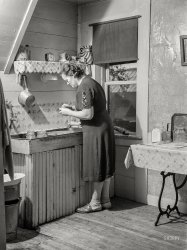
- Cutting Crew: 1911
- ... Maine. All these boys are cutters in the Seacoast Canning Co., Factory #7. Ages range from 7 to 12. Seven year old boy in front, ... Posted by Dave - 12/10/2007 - 2:11pm -
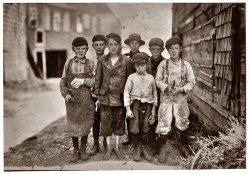
- Zollie Lyons: 1939
- ... building known as a "summer kitchen" where cooking, canning, clothes washing etc could be carried on without heating up the house, ... Posted by Dave - 03/10/2009 - 12:23pm -
![Zollie Lyons: 1939 July 1939. "Zollie Lyons, Negro sharecropper, home from the field for dinner at noontime, with his wife and part of his family. Note dog run. Wake County, North Carolina." View full size. Medium-format nitrate negative by Dorothea Lange.
They all look so tired....Life must not have been too easy back then.
Dog run?What dog run?
[Reference to a southern style of architecture. - Dave]
Re: Dog RunOne purpose of the dog run was to serve as a sort of firebreak. The kitchen was on one side. If a fire broke out there, perhaps the rest of the structure could be saved.
The Lyonses It would be interesting to know what the war did to this family; the years of Southern sharecropping were drawing to a close, and the war could have provided work in factories in the Northern cities.
Additional reading If one wanted to get a real sense of how life was for sharecroppers in the South during the Depression, I can suggest a novel called "Hold Autumn in Your Hand" by George Sessions Perry. I don't know if the book is in print, but used copies are probably at Amazon. I stayed up all night to finish this one.
A good non-fiction work about sharecropping in the South is called "The White Scourge: Mexicans, Blacks, and Poor Whites in Texas Cotton Culture" by Neil Foley. A tough read, but mixed amongst the first-person narratives is a good explanation of the financial aspects of sharecropping, for both the sharecroppers and the owners.
[Thanks for the suggestions. I'd like to throw in a mention for the short stories of Flannery O'Connor. - Dave]
Dog TrotThese cabins, called "dog trots," were found throughout the cotton South, having originated in Appalachia. They featured a center hallway between two "pens" or buildings, where much of the domestic work of the house such as cooking, washing, and food preparation could be done in the shade or out of the rain. Also, ventilation was provided by the center opening. Here is an extensive photo documentation of one of the houses - much like the one pictured here: http://www.greatbuildings.com/buildings/Dogtrot_House.html
Dog run = dog trotThe "dog run" or "dog trot" is the center opening. A lot of Southern homes had a kitchen separate from the main living area, to keep the living area cool. Sometimes homes had a completely separate building known as a "summer kitchen" where cooking, canning, clothes washing etc could be carried on without heating up the house, & also to prevent any fires from burning the main house down. My dad (age 87) says southern men also used to keep a mirror, pitcher & basin, soap, razor, etc on the back porch, so they could wash up & shave out there.
We are the desendantsCommenting on one of the articles The Lyonses- wondering what happened to the family after the war. It was amazing to see our great- grandfather Zollie Lyons on these pictures! How can we get more information? I didn't know that these pictures existed. The family still resides in North Carolina. Please advise of who we can contact for more information.
[This and other photos from this set at the Library of Congress can be found here. -tterrace]
(The Gallery, Dorothea Lange, Rural America)](https://www.shorpy.com/files/images/8b33814u1_0.thumbnail.jpg)
- Table for Ten: 1940
- ... Pot".
I'm guessing the fact that it came in a quart canning jar, which at the time would set you back between 5c and 8c each or ... Posted by Dave - 06/07/2019 - 2:07pm -
![Table for Ten: 1940 October 1940. "Dinner hour at the home of Mr. J.H. Dube, French-Canadian potato farmer, after he and the boys had finished a day's work in their potato field in Wallagrass, Maine." Medium format negative by Jack Delano for the Farm Security Administration. View full size.
Almost CanadaWallagrass is about as far north as you can go in Maine. If you started in New York City and drove to the L.L.Bean store in Freeport, you would be halfway to Wallagrass.
Plenty of mustard“I thought of the anecdote (a very, very old one, even at that day) of the traveler who sat down to a table which had nothing on it but a mackerel and a pot of mustard. He asked the landlord if this was all. The landlord said:
"All! Why, thunder and lightning, I should think there was mackerel enough there for six."
"But I don't like mackerel."
"Oh--then help yourself to the mustard."
—“Roughing It,” Mark Twain
HmmmmmI only count seven children, the others must be in the other room.
["Children"?? -Dave]
Ten?I see a kid who has to stand instead of having a chair of her own, but I still count only nine, whom I take to be two parents and seven children.
None in sightFried, mashed, or baked.
Not even a hint of vodka.
My older sister worked in a bakery. She soon disliked pastries, but she did bring home what didn't sell that day. Perhaps this is why there are no spuds.
Tater totsThe younger ones look like children of the home to me too, and I also count seven, plus two parents.
Be that as it may, I identify most strongly with the older girl on the right, at the end of the table. Her nails are painted and she's wearing a dainty ring. She's got a flower in her hair, which is elaborately curled. I think she managed to get hold of a fashion magazine now and again, even in remotest Maine. And she made an effort to do what my mama called getting "prettied up." Good for her. More spuds, anyone?
#10Look under the table, next to Dad's knee.
Table for ten.I'm thinking you are counting the cat as the tenth one, am I right?
The Tenth DinerUnder the table next to Dad's right leg is then tenth diner, the family cat.
Here Kitty, Kitty, Kitty... and Fluffy makes ten!
How to get sent to bed without any dinnerAw, jeez, Ma, potatoes again?
Yep, There's TenYa gotta count the cat, too.
Rare jar of mustardI have not found any existing examples of the 1815 Prepared Mustard label, although I did find a listing for this product in the April 9, 1943 edition of the "Burlington [Vermont] Free Press" on page 20 in an ad for Colodny's Public Market, under the subheading of "NOT RATIONED-NOT RESTRICTED", advertising "1815 Prepared Mustard...qt jar 19c".
I think this was a product of the Stickney & Poor Spice Co. of Boston who claims to have been the first to import exotic spices into New England beginning in 1815. The company advertised in the early 20th century as being "The National Mustard Pot".
I'm guessing the fact that it came in a quart canning jar, which at the time would set you back between 5c and 8c each or more (there was a war on, you know), empty, made the product a bargain if you planned to soak off the label and reuse the jar for your own home food preservation purposes.
Potato cousinsSeems you have discovered some of my distant cousins. The Dube (pronounced Doobee) families were prominent and large in the area. The original spelling is actually Dubé (pronounced Dubay). I'm not sure where they would fit in the family tree, as I don't know any names here, but I grew up a few miles from there.
(The Gallery, Agriculture, Cats, Jack Delano, Kids)](https://www.shorpy.com/files/images/SHORPY-8c03583a.thumbnail.jpg)
- Hill of Beans: 1940
- ... Mary's County, Maryland. "Mrs. Eugene Smith, FSA borrower, canning string beans." Photo by John Vachon for the Farm Security ... is tired, but -- Mrs. Smith does appear to have a new canning pot, so there's that.
The smell I haven't messed with string ... Posted by Dave - 07/02/2021 - 12:52pm -
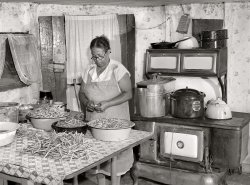
- Kroger Depot: 1941
- ... not be icing cars at their destination. I assume this is a canning plant that gets fruits and vegetables from the West.
Early ... Posted by Dave - 09/03/2020 - 3:33pm -

- The Devil's Workshop: 1911
- ... 1911. Eastport, Maine. "Group of young cutters, Seacoast Canning Co., Factory #2, waiting for more fish. They all work, but they waste a ... Posted by Dave - 06/07/2009 - 12:56am -
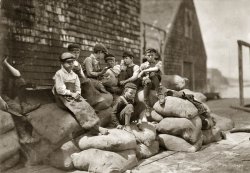
- Five-Tube Chassis: 1937
- ... to see plants full of women performing the cleaning and canning operations. By the turn of the last century, most apparel sweatshops ... Posted by Dave - 05/05/2013 - 7:57am -
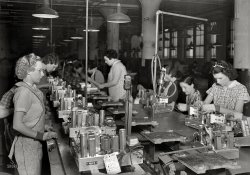
- Power Grab: 1912
- ... "G'wan, I hain't married." The girl steady. Maggioni Canning Company. Port Royal, South Carolina. View full size. ... of the place where the picture was taken (Maggioni Canning Company) suggests otherwise. Is the frase "The girl steady" to be ... Posted by Dave - 09/09/2011 - 12:23pm -
![Power Grab: 1912 February 1912. The Boss taking liberties. "G'wan, I hain't married." The girl steady. Maggioni Canning Company. Port Royal, South Carolina. View full size. Uncharacteristically frisky photo and caption by Lewis Wickes Hine.
Just makes you feelHappy
The BossKind of joke? Is "The Boss" meant here as "husband"? The addition of the place where the picture was taken (Maggioni Canning Company) suggests otherwise. Is the frase "The girl steady" to be followed by something? If not I don't understand it. Due to lack of understanding the English by me perhaps?
["The boss" means her supervisor at work. "Girl steady" means she is his only girlfriend. - Dave]
Who is the little girl then?Who is the little girl then? Surely she's not at work.
[Lots of little girls worked as oyster shuckers. - Dave]
Nice To See....What an endearing and timeless shot this is. It does indeed have a happy and frisky vibe to it. Makes me smile every time I look at it. Interesting for the early 20th century.
(The Gallery, Kids, Lewis Hine)](https://www.shorpy.com/files/images/00985u.thumbnail.jpg)
- Trucked: 1935
- ... farm and barn, public owned gas works, greenhouse, canning works, carpentry shop, cooperative factory, filling station and pool ... Posted by Dave - 09/09/2011 - 12:36pm -
![Trucked: 1935 October 1935. Our third shot of Red House, West Virginia, youngsters on the way to school by truck. 35mm negative by Ben Shahn for the FSA. View full size.
Red HouseYou can almost see the adults that they will become. I love this shot.
Eleanor RooseveltThis is from the Putnam County farm project near Red House (Red House Farms). The project was established in 1934 and was underwritten by the Federal Emergency Relief Administration, a forerunner of the Resettlement Administration and the FSA. There were over 150 families settled at the site who had been receiving relief, and who were to become self supporting through training and farming. It was called a "subsistence homestead community."
Notice the "government house" on the right side of the frame. Each was on an acre of land along with a small barn, chicken pen and garden. The houses were mainly of cinderblock construction, but knotty pine inside. There was also a community farm and barn, public owned gas works, greenhouse, canning works, carpentry shop, cooperative factory, filling station and pool room.
And the poster is correct, you can see the sort of adults that they would become.
Eleanor Roosevelt was one of the most important voices in establishing these communities, and the site is now called Eleanor. It claims to be "the cleanest town in West Virginia."
http://eleanorwv.20m.com/p8.htm
Red HouseThey all look so happy to be going to school. Wonderful picture.
I keep coming back to this photo.What I can't get over is that it would seem that it's a chilly day, judging by the fact that most of the kids are in heavy sweaters or jackets. Yet the boy in overalls and at least one other (the boy with his back to the camera) aren't wearing shoes. Their toes must have been frozen!
But what really gets me is thinking how times have changed. Twenty-five years or so ago, I was the same age as many of the kids in this photo. In my school, you were often ridiculed for not having the "correct" $100 Nikes. Yet in this photo, no one seems bothered in the least that some in the group don't even have shoes.
Makes me wonder what happened between now and then....
Houses in Red House FarmsI am an originia [?] family child and still one of the 150 houses in Eleanor WV also known as Red house Farms. The clothing the children had on was what they had. Some would wear a jacket or coat over a torn dress so it wouldn't show. Some of us had shoes, some didnt. There were 150 houses and three repalacement houses for the three land owners who chose not to sell to the Gov. in 1934. The house referred to in the picture is still standing however there was NO knotty pine in the houses, it is all wormy chestnut. Stll very much in demand when it can be found. As I said I own one of the homes yet. The truck is parked in front of the barracks where school was being held. The working men had lived there before the families moved in. What a special Bonding the remaining children have today. We are proud to be called Project children.
Marlane Crockett Carr
The kidsHi Marlane,
I was wondering if you could identify any of these children as any of the Burgess children -- Jean, Leland, Corliss (Burl), Willo or Lillie.
Thank you,
Sheila
(The Gallery, Ben Shahn, Cars, Trucks, Buses, Education, Schools, Kids)](https://www.shorpy.com/files/images/8a16724u.thumbnail.jpg)
- War and Peas: 1919
- ... Part of it is the way that they're treated during the canning process and part is that they're allowed to wait a long time before ... Posted by Dave - 08/27/2012 - 3:21pm -
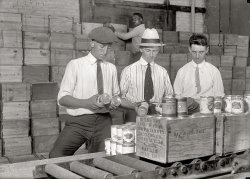
- Pressure Cookers: 1941
- ... Pay attention! The borrower seems to know something of canning with all that's alongside the cooking vessel. But, I hope she paid ... Posted by Dave - 02/28/2020 - 4:42pm -
![Pressure Cookers: 1941 July 1941. "Wife of FSA borrower discussing pressure cooker with home supervisor. Mille Lacs County, Minnesota." Medium format negative by John Vachon. View full size.
Re: BethFThank you very much for your kind words, jd taylor. You made me blush. I firmly believe everyone should eat like they're 8 years old again every once in a while. There's nothing wrong with it. Adult life can be very stressful for any number of reasons, so taking a few moments to be a kid again can reset your equilibrium. At least, it works that way for me.
BethFThat’s one of the best Shorpy comments ever. And this is one of the best lines: “I eat like I'm 8 years old again.”
Grace under pressureYour face is a study in terror, Grace Swenson, and can't say as I blame ya. If I had a 'splodey old pressure cooker like that in MY kitchen, I'd be sayin' novenas!
Well, I'd best be on my way. The day is young, and I have a lot more supervisin' to do. Thanks for the tequila shots!
The NationalJudging from the general shape, the lugs, and the dial, I believe we're looking at a National C21 pressure canner ("21" indicated the capacity in quarts). Smaller-capacity National models used a twist-lock top.
When will it blow?Fabulous photo with its foreboding shadows on the brown paper walls. They both wait for the explosion of the pressure cooker. Who got the timing correct? Mother or daughter?
[That's not her daughter! - Dave]
Mille LacsOnly a thousand lakes? The licence plate has 10,000. And not to be outdone, my home province, Manitoba, just to the north, when I was a kid, decided to go with ten times as many lakes.
All those knobsWon't do a bit of good!
Memories from my childhood.My grandmother had a pressure cooker that looked very similar to this one, and without fail, whenever we went to visit her, she'd cook fresh green beans (picked from the garden that day) and lots of bacon in it. It was amazing. I used to only be able to eat green beans like that, so it was a good thing my mother had one too, albeit a newer model. I've since learned to enjoy green beans in a myriad of different ways, but for good old nostalgia's sake, I make them the way my grandma did, and I eat like I'm 8 years old again.
Pay attention!The borrower seems to know something of canning with all that's alongside the cooking vessel. But, I hope she paid more attention to the pressure gauge than she paid to changing her calendar page.
We still have, and use, a pressure cooker that my mom had from the late forties or early fifties. No trouble yet. Knock on wood.
(The Gallery, John Vachon, Kitchens etc.)](https://www.shorpy.com/files/images/SHORPY-8c19860a.thumbnail.jpg)
- Fast Woman: 1908
- ... company far better known for their apple peelers and food canning machines. The Maryland started out in 1905 as the Ariel, made by the ... Posted by Dave - 04/06/2013 - 11:24pm -
![Fast Woman: 1908 Washington, D.C., circa 1908. "Maycliffe, R., Miss." The Broadway ingenue Ruth Maycliffe. Harris & Ewing Collection glass negative. View full size.
1907 OaklandYou can see part of the last name on the radiator. Here's a picture for reference. Not identical, but a lot of the details are strikingly similar, like the horn, running lights and headlights.
Backwards DriverJudging by the tire tracks is looks like the car was reversed into position for this shot.
Where was she?Can anyone identify the location and the buildings in the background?
[The big building is the Willard Hotel. - Dave]
AH-OOGA.Where do I get me one of them horns?
Multiple Air Valves?I am no car expert, and have no idea what kind of a car this is.
BUT, I notice that the tires seems to have a whole lot of air valves, if that's what they are, whereas today's tires have only one per tire.
Does anyone know why?
[Those are rim clamps. See the comments here. - Dave]
LocationFor the individual curious about the location of this photo. Thanks to Dave's identification, the Willard Hotel is located at 1401 Pennsylvania Ave NW, DC. Just down the road from the White House.
It's a MarylandMiss Maycliffe's car was a rarity even when this picture was taken. It is a 1908 Maryland Roadster as manufactured by the Sinclair-Scott Company of Baltimore, a company far better known for their apple peelers and food canning machines. The Maryland started out in 1905 as the Ariel, made by the Ariel Motor Car Company of Boston (not connected with the Ariel Motor Company in England or its New York partner The Ariel Company).
Sinclair-Scott had ventured into the manufacture of car parts a few years earlier and Ariel became one of their customers—in fact Sinclair-Scott was soon not only producing most of the car, but assembling it as well. There were few sales of the $2,500 tonneau however, and Ariel was unable to make good on their debts. Sinclair-Scott acquired the rights to the vehicle in 1907 (Ariel Motor Car Company was officially dissolved that same year), gave it a bit of a face lift—the oval radiator was given a sleeker redesign—and renamed it the Maryland Car.
They next added a 6-passenger limousine and a 2, 3, or 4-passenger roadster to the lineup while retaining the dash and Briscoe oval radiator on all three models. The Briscoe Mfg. Co. badge can be seen at the top of Miss Maycliffe's radiator.
Sinclair-Scott also carried on the Ariel tradition of equipping each vehicle with a tool box, a Nonpareil brand horn (used by 2/3 of American automobile manufacturers) and a full set of Atwood lamps (2 oil side lamps and 2 acetylene head lamps).
The new models were a vast sales improvement over the Ariels—albeit still fairly low volume when compared to the best-sellers of the day—and for 1908 the only changes made were some body refinements and to the finish. Given the low production volume, it is possible that the roadster Miss Maycliffe purchased was the very one used for the promotional photographs appearing in national magazines (above).
Even with the increased volume, the vehicles were never profitable enough for Sinclair-Scott and in 1910 they discontinued the Maryland Car line. I am unaware of any Ariels or Marylands in existence today—making them both extinct cars.
(The Gallery, Cars, Trucks, Buses, D.C., Harris + Ewing)](https://www.shorpy.com/files/images/SHORPY_15819a.thumbnail.jpg)
- Cannery Row Fire: 1967
- ... Herald:
"On Sunday, Dec. 24, 1967, the old Carmel Canning Company on Cannery Row caught fire and burned for more than four hours. ... Posted by rsyung - 08/10/2016 - 8:52pm -
![Cannery Row Fire: 1967 Kodachrome slide taken by my dad while we were in Pacific Grove for the Christmas holiday, December, 1967. From the Monterey Herald:
"On Sunday, Dec. 24, 1967, the old Carmel Canning Company on Cannery Row caught fire and burned for more than four hours. The blaze, which had more than 65 firemen respond from Monterey, Seaside and Pacific Grove, caused an estimated $250,000 in damage. Fire and smoke billowed from the structure, causing embers to fall on homes in New Monterey and start smaller fires. Fire Chief Clifford Hebrard said it was his opinion “that the fire was set.” An arson investigation was to take place the next day." View full size.
School's outSeeno St next to Larkin Elementary.
Monterey fire from a 1965 Monterey.It was indeed a Mercury Monterey, although if I remember right, a 1965 model. My dad bought it used.
After the fire. Ruins of fire-ravaged cannery. This was at the corner of Cannery Row and Hoffman.
1967?Are you sure the year is 1967? That looks like the rear end of a late '70's, early '80s Olds - like a Delta 88 or a 98.
[Appears to be a 1966 Mercury Monterey 2-door sedan. -tterrace]
Cui Bono?This fire was the major event ultimately leading to the complete gentrification of what had long been a picturesquely seedy area. Save for a few bars/restaurants (Neil Devaughn's, The Place, the Outrigger) and a movie theater, Cannery Row largely comprised abandoned canneries and dilapidated shacks, hardly a destination for anyone outside the Monterey Peninsula.
Now, of course, upscale hotels, an internationally renowned aquarium, and bars and eateries galore compete with T-shirt shops and the few remaining original buildings (suitably rehabbed, of course) for the attention of tourists from all over.
There was, of course, considerable malicious gossip, since much of the Row had been acquired by a local development firm prior to the conflagration and there was a longstanding development v. preservation controversy seething at the time. No charges were ever filed, let alone proven, and the Monterey tax base got a nice shot in the arm after things started spiffing up. And any number of young locals, whose parents and grandparents had either fished for sardines or canned them (contributing to what was known to locals as "The Stink By the Bay"), became employed in more genteel occupations.
Locals don't go to Cannery Row.Lived in Monterey for a year in the 1970's, going to language school. At that time Cannery Row was fascinating mix of the old, the weird and the new. Can't forget the tiny 812 Cinema, where you laid on cushions to watch the movie, or Odyssey Records.
Came back in the 1990's for a final tour at the language school and have stayed ever since. A great deal had changed on Cannery Row. The 812 was gone, as was Odyssey Records. The Aquarium was there. Cannery Row had turned totally touristy.
We locals only go to Cannery Row to take out-of-town visitors. For us, the character is long gone.
(ShorpyBlog, Member Gallery)](https://www.shorpy.com/files/images/CanneryRowFireDec24_1967.thumbnail.jpg)
- Lil Shuckers: 1912
- ... and on Saturday from 4 a.m. to early afternoon. Maggioni Canning Co." View full size. Photo and caption by Lewis Wickes Hine.
... Posted by Dave - 02/06/2008 - 7:58pm -
![Lil Shuckers: 1912 February 1912. Port Royal, South Carolina. "Nine [?] of these children from 8 yrs. old up go to school half a day, and shuck oysters for four hours before school and three hours after on school days, and on Saturday from 4 a.m. to early afternoon. Maggioni Canning Co." View full size. Photo and caption by Lewis Wickes Hine.
SmilesEven tho these kids worked really hard, there are still times for wonderful smiles from the three girls on the right. Beautiful.
Poor kidsJust imagine, between other things, attending school smelling like that.
"I hate taking pictures"My favorite is the little boy in the back who is glaring at the camera. Kinda reminds me of my cousin on Easter.
(The Gallery, Kids, Lewis Hine)](https://www.shorpy.com/files/images/05333u.thumbnail.jpg)
- Plucky: 1936
- ... of hired hand cleaning chickens in cellar preparatory to canning them. Chickens at this time of year are bringing six cents per pound. ... Posted by Dave - 09/09/2011 - 2:27pm -
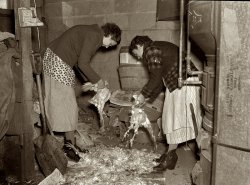
- Well-Preserved: 1940
- ... people don't know that there is a nationwide shortage of canning supplies here in 2020. Due to the unprecedented and bizarre state of ... Posted by Dave - 09/12/2020 - 12:11pm -
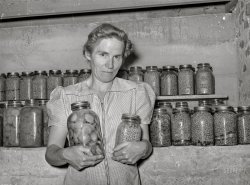
- Tiny Shucker: 1912
- ... go to school. Works steady. Been at it one year. Maggioni Canning Co. Port Royal, South Carolina." Photograph by Lewis Wickes Hine. ... Posted by Dave - 03/14/2016 - 2:14pm -
![Tiny Shucker: 1912 February 1912. "Tiny, a seven-year-old oyster shucker (sister of Henry, No. 3291), does not go to school. Works steady. Been at it one year. Maggioni Canning Co. Port Royal, South Carolina." Photograph by Lewis Wickes Hine. View full size.
I've consumed many an oysterBut have shucked nary a one. Still, judging from the heavy gloves sturdy adults use when performing that task, I am surprised that this poor little waif has any hands left. I presume, of course, that she hadn't a tiny pair of work gloves, given her obvious place in the socio-economic hierarchy of Port Royal.
Child LaborPoor kid already looks like someone's grandma.
The other side of seafoodNo idea what it's like today, but I saw a lot of how the seafood industry worked in Florida in the mid-1960s. My dad, for a couple of years, was manager of what was at that time the largest seafood company in the U.S. To teach me the value of an education, he arranged for me to work at one of the plants in Marathon, Florida, that "processed" fresh mackerel. Beheading, gutting, and rinsing the fish and putting them into a wire basket was the task when the fishing boats came in, and that began at four in the morning. It took 11 cleaned fish to fill the wire basket, and you got 25 cents a basket. I was supposed to do that for a week; one day was all I could manage and I'll never forget it.
Later, when living in Apalachicola, Florida, I'd go down to the packing plants where older black women shucked oysters. These women were so skilled it was almost beyond belief, and they had worked together so long that it seemed like a social event as they joked and sang and teased each other. That proved, to me, their tough spirit and great skill. The work was not only not fun but tedious and dangerous; handling those peculiar stiff-bladed oyster knives was not something you did without paying attention. I did admire those women so and was proud they accepted me as a friend.
I think a bit misleadingI shucked oysters as a thirteen yo female in my family's restaurant in Louisiana. The leverage it takes to break the hinge on the oyster would be beyond her ability, I would say, but who knows. I would think her job would have been to break apart the clusters of oysters with a hammer to separate them for the shuckers.
[Not misleading. They used knives. She was one of hundreds. - Dave]
(The Gallery, Kids, Lewis Hine)](https://www.shorpy.com/files/images/SHORPY-05335u.thumbnail.jpg)
- Cannery Row: 1912
- ... and partly surrounded by a tidal marsh. Maggioni Canning Co." Photograph and caption by Lewis Wickes Hine. View full size. ... Posted by Dave - 10/28/2012 - 12:09pm -
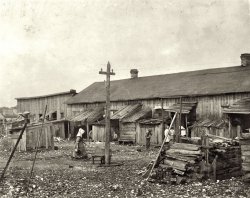
- Step Sisters: 1911
- ... are at the factory. She shucks [oysters] also. Alabama Canning Co." Photograph by Lewis Wickes Hine. View full size.
The Eyes ... Posted by Dave - 02/07/2014 - 10:08pm -
![Step Sisters: 1911 February 1911. Bayou La Batre, Alabama. "Little Julia tending the baby at home. All the older ones are at the factory. She shucks [oysters] also. Alabama Canning Co." Photograph by Lewis Wickes Hine. View full size.
The Eyes Have ItHines outdid himself with this one. The little girl's eyes are just amazing.
SweetThis is such a sweet photo. I hope these little angels had wonderfully happy and long lives.
(The Gallery, Kids, Lewis Hine)](https://www.shorpy.com/files/images/SHORPY_00850u.thumbnail.jpg)
- This Land: 1940
- ... for them to ship fresh fruit than places further west. Canning and drying was more common at points west, such as the San Joaquin and ... Posted by Dave - 09/19/2018 - 2:11pm -
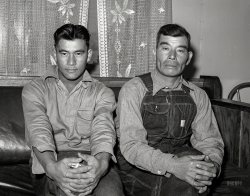
- My Grandfather: 1915
- ... fleet of these ships and they were involved in the salmon canning industry in Alaska. Outbound from San Francisco, they hauled up ... Posted by Bob Burns - 10/25/2021 - 2:51pm -
